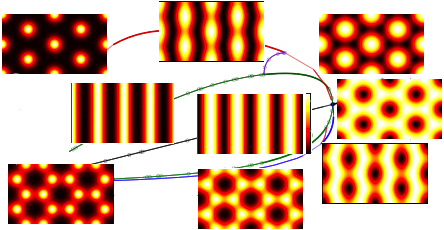
Movies created in some pde2path demos
Home |Tutorials and Demos | Applications| Backlog
 |
Movies created in some pde2path demosHome |Tutorials and Demos | Applications| Backlog |
| 1D Allen-Cahn (AC) equation with imperfect bifurcations due to a nonhomogeneous Dirichlet BC at the right. See AC-tutorial. | Two snaking branches of localized rolls in the 1D Swift-Hohenberg (quadratic-cubic) equation, see PF-tutorial (§3.2), and demos/pftut/sh/bdmov1D.m | The 2D SH equation on a 'medium size' (quite small actually) domain see PF-tutorial (§3.8), and demos/pftut/sh/bdmov2D.m |
| The 3D SH equation on a long and slender bar, meant to illustrate localized 3D patterns, generated by initial guess; blue and red branch are BCCs and tubes, respectively; see PF-tutorial (§3.8), and demos/pftut/sh/bdmov3D.m | A 'wandering boundary spot', meant to illustrate 3D mesh-adaption (slightly dragging behind the spot) by trullekrul. See Trullekrul-tutorial and demos/acsuite/ac3D/bdmovie3Dws.m. | The 2D Schnakenberg RD system on a long and slender rectangle, illustrating 'beans' (orange) with bifurcations hexagons embedded in stripes; see PF-tutorial (§4.2), and demos/pftut/schnakpat/bdmov2D.m |
| The AC equation on a sphere, see PF-tutorial (§6.2), and demos/pftut/acS/bdmovacS.m. | >The Schnakenberg RD system on a torus, see demos/pftut/schnaktor/ and PF-tutorial (§6.4). | The cubic quintic SH on a disk, here focussing on "daisy patterns", see here and /demos/JBDMV/sh35disk/ |
| A four-armed snaking branch for SH35 on a disk, as one of the many further solution classes. | For BDs with branches of periodic orbits (POs), we can create movies showing these at fixed parameter values. Here the complex Ginzburg-Landau (cGL) equation on a square, see hopfdemos/cgl/cmds2dsq.m (and sqmov.m). | The cGL equation on a disk (O(2) symmetry), see Hopf tutorial (§6.2) and hopfdemos/cgldisk/cmds2d.m |
| The next 6 movies are from Geomtut. We start with mean curvature flow (MCF) from near a slightly unstable Enneper surface to the bifurcated surface with slightly lower area A, see demos/geomtut/enneper. | Constant mean curvature (CMC) nodoids between two circles of radius 1 at distance 1; starting with a (stable) cylinder we obtain bifurcations to non-axisymmetric branches, see demos/geomtut/nodDBC/cmds1.m | "Long nodoids", starting with a nodoid with one inner buckle, demos/geomtut/nodDBC/cmds2.m |
| Nodoids with periodic BCs in z, here on twice a minimal period cell, demos/geomtut/nodpBC/ | Continuation of the Schwarz P triply periodic minimal surface in the period in z, demos/geomtut/TPS/cmds1.m | CMC H ≠ 0 companions of Schwarz P, demos/geomtut/TPS/cmds2.m |